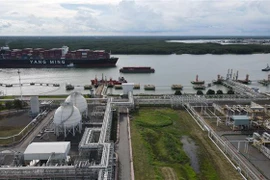 An aerial view of part of the Thi Vai liquefied natural gas (LNG) warehouse and terminal complex (Photo: congthuong.vn)
An aerial view of part of the Thi Vai liquefied natural gas (LNG) warehouse and terminal complex (Photo: congthuong.vn)Hanoi (VNA) – The Thi Vai liquefied natural gas (LNG) warehouse and terminal complex, the first of its kind in Vietnam, of the Petrovietnam Gas Joint Stock Corporation (PV GAS), has passed a series of technical tests and is now ready to be put into commercial operation.
Work started on the Thi Vai LNG warehouse and terminal projects, based in the southern province of Ba Ria - Vung Tau, on October 28, 2019. Their trial operations began on July 10, 2023, and the test run of the main processes completed on July 30.
The Thi Vai system is currently the biggest LNG complex in the country. The LNG warehouse, the heart of the system, already had its first phase completed with the storage capacity of 180,000 cu.m., able to handle 1 million tonnes of LNG per year. Its second phase is currently under construction with a view to raising the annual handling capacity to 3 million tonnes.
Meanwhile, the LNG terminal is capable of serving vessels with deadweight tonnage (DWT) of up to 100,000.
The Thi Vai LNG complex will be an important link in the provision of deliquefied LNG and ensure the uninterrupted supply of gas for existing clients and new power plants under the Prime Minister-approved general plan on developing Vietnam’s gas industry until 2025 with orientations toward 2035.
It is expected to provide about 1.4 billion cub.m. for clients and make up for part of the domestic gas shortage after 2023.
A leader of PV GAS, an affiliate of the Vietnam Oil and Gas Group (Petrovietnam), said the trial operations showed the Thi Vai LNG warehouse has met all criteria and requirements, with absolute safety for people and equipment guaranteed, nearly three days ahead of schedule. The reception of LNG from the first vessel carrying imported LNG to Vietnam was also completed two days early.
The facilities have successfully imported the first batch of LNG and run on a trial basis, supplying 20 million cub.m. of LNG for the market as of July 31, 2023.
However, to secure success for the complex, it is necessary for policies to be issued to promote the distribution of LNG in the market, to not only industrial clients or future LNG-fired power plants but also existing gas-fired power plants amid the dropping domestic gas supply and slower-than-expected implementation of the plan on developing new gas sources.
Since 2015, the annual volume of gas provided for power generation is 8.8 billion cu.m. at the maximum, including 7.3 billion cu.m. for the southeastern region and 1.5 billion cu.m. for the southwest.
However, the domestic gas supply for electricity production is falling sharply, to about 4.3 billion cu.m. for the southeast and 1.4 billion cub.m. for the southwest in 2023. The supply for the regions is forecast to respectively decline to 1 billion cu.m. and 0.6 billion cu.m. by 2030.
According to the National Power Development Plan for 2021 - 2030, with a vision to 2045 (Plan VIII), the electricity generated by using domestic gas supply and LNG will reach 37,330MW by 2030, equivalent to 24.8% - the largest share - of the total, including 14,930MW from the use of domestic gas sources (9.9%) and 22,400MW from the use of LNG (14.9%).
With the goal of eradicating coal use in power generation by 2050, gas-fired power plants will play a crucial role in the national power system since they are not affected by weather compared to hydro, wind, or solar power. In addition, those plants also have high readiness, big capacity, quick response, and minimized emissions of greenhouse and polluting gases.
Therefore, the use of LNG is also in conformity with the Vietnamese Government’s commitments made at the 26th United Nations Climate Change Conference (COP26) and the trend of using low-emission fuels./.





























